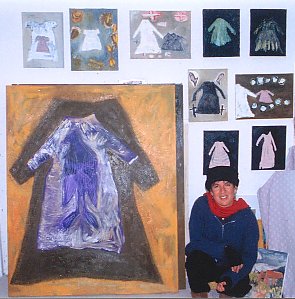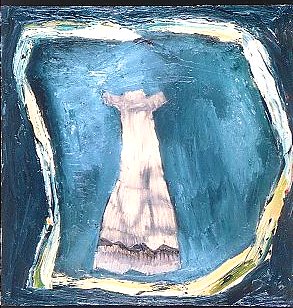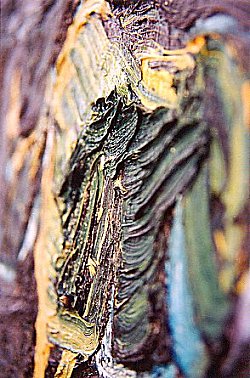Bending Rules, Blending Worlds:
Selena Engelhart's "Cosmology"
Atomic Cafe, Santa Fe, New Mexico
an essay by Richard Speer
Blending worlds, conjuring visions of arcane spirits, painter Selena Engelhart creates iconic symbologies that crackle with synergy. Pagan and Christian, Latino and Native American, material and other-worldly, human and bestial -- these are realms she manages to integrate in works whose very titles betray a uniquely polymorphous compounding: Owl Women... Antler Woman... Fire Hydrant Dress... She births cosmoses in which Mayan gods, Native American kachinas, and Catholic icons mingle, seduce, and frighten, connecting us with the primal within and the sublime without.Growing up in Berkeley, California, during the tumultuous 1960s, the daughter of a jazz-pianist father and political-activist mother, the artist showed early aptitude for both music and art. As a child she studied classical piano and began drawing and painting in nursery school. But her genesis as a serious artist came in her early twenties, in the aftermath of a profound experience she is reticent to discuss in detail, but which she describes as shamanic.
"It was a catalyst for bringing out something that was already inside me," she says. "Like all shamanistic experiences, it was really about the shattering of the ego. It was as if the gods were whipping me to the ground. Afterwards, I couldn't bear any intensive stimulation, so I started painting watercolors as a way to organize my thoughts and put myself back together. I began painting the universe in abstraction.; then, Mayan gods from glyphs I was familiar with from my studies and from living in Mexico. Finally I arrived at painting fetuses and the human body. During that one year alone, I did 63 paintings."
Ghost Dress in a Well, 1997. Oil on canvas, 30" x 30".
Subsequently, Engelhart studied in Florence, New York, and the San Francisco Bay Area, where she studied in the atelier of Louise Smith while doing undergraduate work at the California College of the Arts. She also studied under Franklin Williams as an undergraduate and during the course of her Masters of Fine Arts studies at Mills College in Oakland. "Franklin Williams really freed me up to see myself as I really was," she says. "He allowed me to step inside my painting."Her artistic reach broadened in succeeding years, even as her subject matter became almost monomaniacally focused: the exhaustively inventive variations on dresses; a series in homage to the American buffalo; studies of the Virgin of Guadalupe... The tranquility of her Santa Fe studio belies the churning phantasmagorias that emerge from her brushes. "When you're out here in the desert, the rest of the world melts away. The elements are strong. The sun is more harsh than nurturing. There's a sense of isolation from the outside world -- very different from Berkeley, which is so worldly and diverse. But living and working here have connected me to nature in a powerful way."
Detail, Night Buffalo, 1997. Oil on canvas, 11" x 14".
In the application of paint we discern the drama of Engelhart's inner world. The brushstrokes swell, crest, and fall, the oils gloppy and luxuriant. She traffics in iconography that functions as shorthand for larger abstractions: crucifixes and cathedrals, skulls, moons, and antique dresses in whose folds the ghosts of former wearers linger. There is something of the cave-painting or petroglyph in the symbologies she conjures, which speak to us even in their silence. Like Willem De Kooning and Jean-Michel Basquiat, whom she cites as influences, she is unafraid of imagery that is raw and unpretty. No one will mistake her elemental buffalos for the pastorales churned out by the retro-Remingtons who have turned "Southwest Art" into an epithet. In the primitivist tradition, she sometimes distresses surfaces, dragging rusty nails across fresh paint to impart emotion via texture.
Her modus operandi -- narrative and symbolist -- is dialectic in the sense of razing formal and expressive dichotomies. This would seem a natural orientation for a woman born to a German-Dutch father and a Mexican mother; perhaps it is this collision of Teutonic-Protestant and Latin-Catholic paradigms that precipitated her penchant for cultural mélange. In the complexities that arise from the seeming simplicity of her imagery we sense the source of Engelhart's power: integration, paradox, sorcery.
-- The author of Matt Lamb: The Art of Success, Richard Speer is a contributing critic at ARTnews, contributing editor at Art, Ltd., and visual arts critic at Willamette Week, the Pulitzer Prize-winning alternative weekly in Portland, Oregon.
BACK TO RICHARD'S WELCOME PAGE


